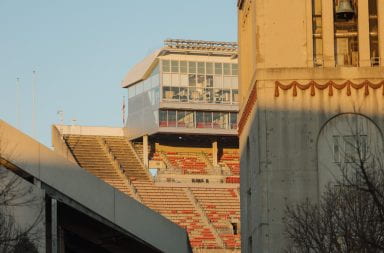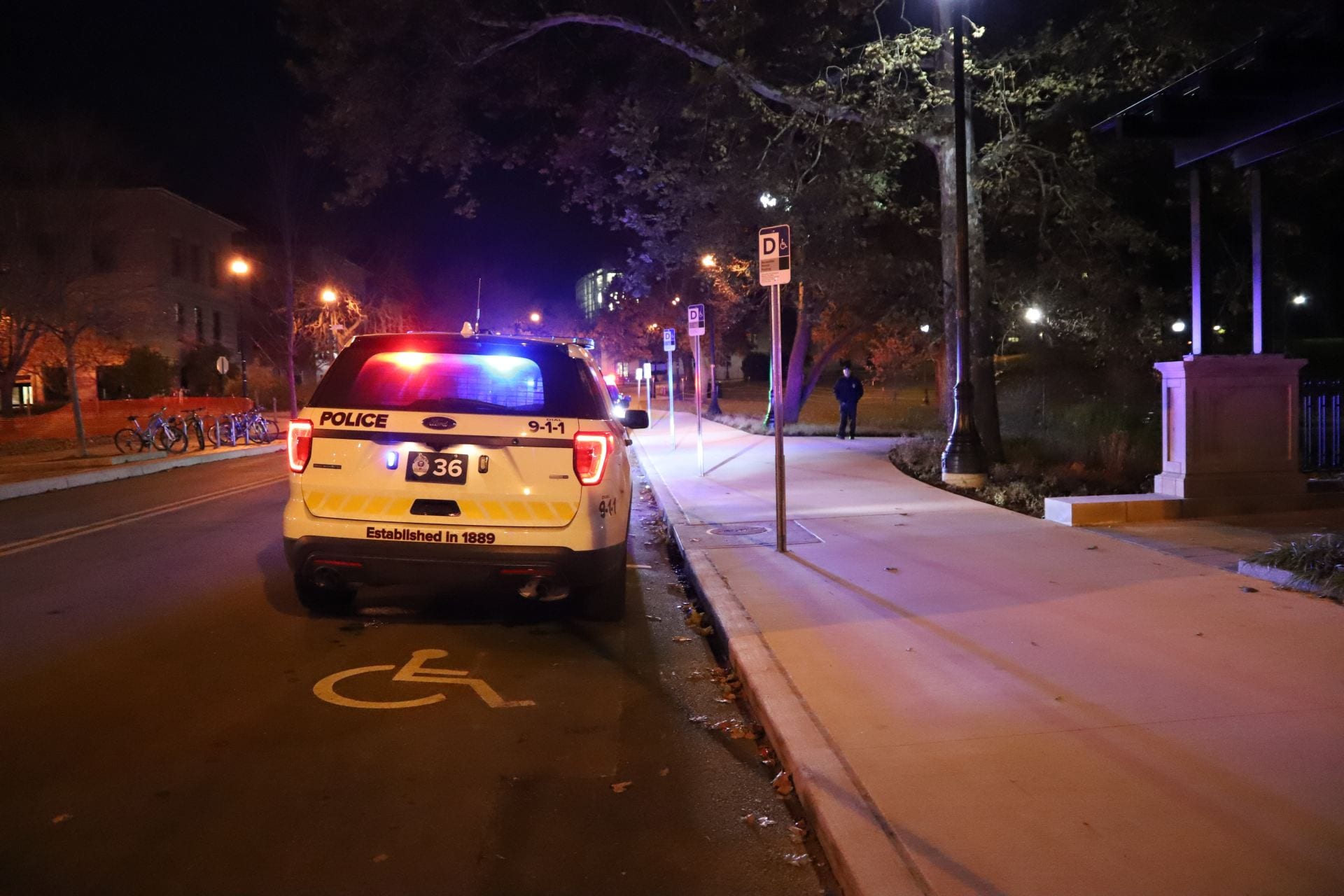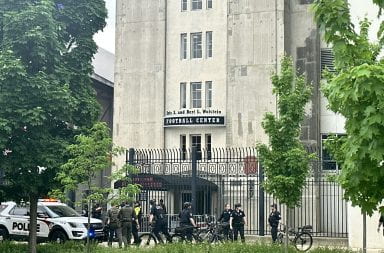The pink ties on wooden stakes winding around the landscape of an Ohio State soccer field are cold, hard proof that change is coming soon.
A towering sycamore behind the Biomedical Research Tower on 12th Avenue is living on borrowed time.
The tree is in the way of progress via One Framework, a university initiative, and the creation of a permanent road.
And it’s not just any old tree — it is one of the largest trees left on campus and is 150 to 200 years old.
The sycamore is one of two large ones in the immediate area and is located between Cannon Drive and Neil Avenue.
The one to be removed is near outdoor seating and offers shade or cover from the rain.
Lauren Tilley, a clinical research data coordinator, works near the other large sycamore with an Ohio Staters historical marker, and seeing it throughout the day gives her a much-needed boost after being in the lab. She’s in labs almost all the time while working at Tzagournis Medical Research facility.
It’s a cause that has given her a focus and an energy she did not know she had.
All for a tree.
Tilley is not an avid environmentalist.
“It was a call to action, and I felt like no one else was going to say anything,” Tilley said.
She started writing editorial letters to The Lantern and The Columbus Dispatch.
Another letter was to President E. Gordon Gee.
“Mostly President Gee, I’ve been selfish,” Tilley wrote. “I’ve taken for granted the beauty of the landscape of the university, its presence of mature trees and its diverse landscape. Until now, these were things I assumed were constant, and protected.”
Gee was asked about the plans for removal of the tree during a recent Lantern quarterly meeting.
“If we can save it, then that’s always good,” Gee said. “Sometimes if you can’t save something then what you do is plant another tree. That is the unfortunate reality when you’re in a campus or when you’re trying to make some progress as an institution.”
A friend of Tilley’s, Josh McElhaney, started an online petition supporting keeping the trees. McElhaney is a laboratory assistant at Tzagournis,
As of Tuesday evening, the petition had more than 1,200 signature.
One recent one was from as far away as California. Many of the petitioners have left comments about losing a sycamore.
There’s also a Facebook page.
Some of the tree’s benefits cannot be measured in dollars, culturally or historically.
Stormwater remediation is one of the biggest environmental impacts of trees, especially one the size of the tree that is to be removed, said Jim Chatfield, an OSU horticultural specialist.
Chatfield is scheduled to speak about “Why Trees Matter” at an Oval dedication and planting of an oak tree on Arbor Day.
The Ohio Staters marker claims the site is important to the history of the campus — and the underground railroad.
“I helped place those markers,” said Stephen Volkmann, a university landscape architect.
The goal was to place five markers in areas with historical significance.
As part of the history of the university, it is hard to place a true value on the total cost of losing either of the sycamores, Tilley said.
Others agree with the personal costs to losing the tree.
“Where you see greenery, you want to be in that same place,” said George Mursean, a second-year medical student.
Road construction of a two-lane road that will also have two bicycle lanes will start in August, Volkmann said.
The effort is intended to relieve traffic congestion from 12th Avenue.
The project takes a long-term approach as to what will best benefit the community, he said.
Volkmann is an adviser on the university’s One Framework project that is part of the future road construction.
“We’re also trying to make sure that the one tree we are saving will
have the very best chances of survival,” Volkmann said.
The bulk of the roots are on the north side of that tree, and will not be compromised by construction activity, Volkmann said.
Eventual plans for the area include a learning environment that will engage the community.
The area will also contain the equivalent of a native planting of trees — more than typical streetscaping — and extensive greenery, Volkmann said.
New plantings could take 25 to 50 years to reach maturity, depending on what is planted, Volkmann said.
Planners for the site are consulting members of Food, Agricultural and Engineering Sciences to help with the process.
“It’s always unfortunate that we have to take a tree down for any reason,” Volkmann said.
But there’s a balancing act.
Volkmann said it is good that people are taking action to save the trees.
“I’m glad of the public outcry because out of that we saved one of the sycamores,” Volkmann said.
Some people have said the road by the sycamores is temporary, but it will be permanent, Volkman said.
It is not possible to go around the sycamore because doing so would affect the root system of the one that is being removed, Volkmann said.
Moving the road now would affect Recreation Sports land that is currently used for soccer.
But an artist’s rendering of the plans for the landscape show buildings on both sides of the road.
The Rec Sports area could disappear eventually, Volkmann said.
You never know when a donor might come in and say, “Here’s the money for a building,” he said.
The road should not go into the soccer field, said Mohamed Almutawa, a first-year in accounting.
“We want the fields,” he said. “Take the tree.”
Almutawa said he and his friends play soccer every day, and it’s a way to relieve the stresses of studying.
The road will be part of John H. Herrick Drive and will eventually connect with Kinnear Road. The first year, the road will be built, and the next year, landscaping will be added, Volkmann said.
There are plans for a temporary part of the road that will affect the south Lincoln Tower parking area.
The Ohio Historical Society will sometimes get involved in conflict regarding historical sites, but it does not currently have any plans to get involved.
“There are some sites that are on the national register without a building,” said Kim Schuette, communications manager for the Ohio Historical Society.
Because there is not an exact address where the sycamores are located, Schuette was not certain if the sycamores were on one of those sites.
Even if it is, it “doesn’t preclude the owner of the property from changing the property,” Schuette said. “It just raises awareness.”
Tilley is still not sure what she is going to do next with the signatures on the petition. She said she just wants to keep the history of the area intact and save the tree that will be removed.
“How can you be a university landscape architect if you can’t be a steward to its own landscape,” Tilley said.
Volkmann has worked at OSU for seven years, and his first major project was “trial by fire” in creating plans for the Oval. The public was concerned about plans there also, but those ultimately worked out for the best, Volkmann said.
When considering progress, the longterm view is important, he said.
“We believe it will make it a better campus all the way around, otherwise why would we do it?” Volkmann said.


